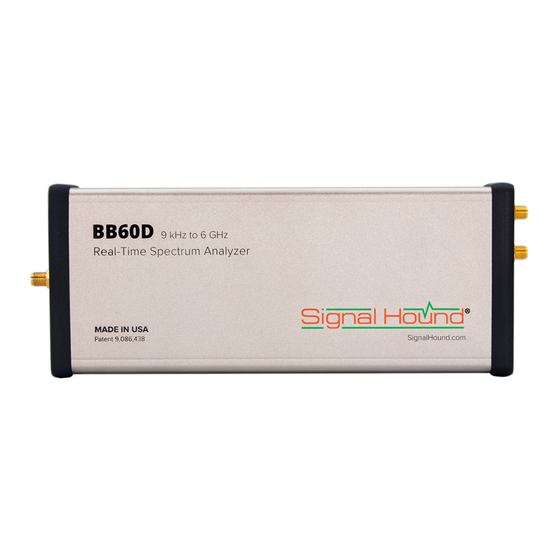
Advertisement
Quick Links
Advertisement

Subscribe to Our Youtube Channel
Summary of Contents for Signal Hound BB60D
- Page 1 BB60D Spectrum Analyzer Product Manual...
- Page 2 Signal Hound BB60D User Manual Published 6/14/2022 ã2022, Signal Hound 1502 SE Commerce Ave, Suite 101 Battle Ground, WA Phone 360-313-7997 This information is being released into the public domain in accordance with the Export Administration Regulations 15 CFR 734...
-
Page 3: Table Of Contents
Contents 1 Overview ................................4 2 Preparation ............................... 4 3 Understanding the BB60D Hardware ......................7 4 Troubleshooting ............................. 10 5 Calibration and Adjustment .......................... 11 6 BB60D Preliminary Specifications ....................... 11 7 Warranty and Disclaimer ..........................13 8 Appendix ................................. 14... -
Page 4: Overview
80 million samples per second, and streams data to your computer at 140 MB/sec. By adding a high-speed hard drive to your PC or laptop (250 MB/s sustained write speed), the BB60D doubles as an RF recorder, streaming up to 80 million IF samples per second, or 40 million I/Q samples to disk. - Page 5 • OpenGL 3.0 capable graphics processor** (* We do not recommend running the BB60D in a virtual machine (i.e. Parallels/VMWare/etc.)) (** Certain display features are accelerated with this functionality, but it is not required.) (***Our software is optimized for Intel CPUs. We recommend them exclusively.) (†...
- Page 6 Spike software manual and BB60 API manuals for more information When paired with a USB-TG44A, or a USB-TG124A, the BB60D may be used as a scalar network analyzer. See the Spike software manual for more information. The BB60D is not recommended...
-
Page 7: Understanding The Bb60D Hardware
3.1 Front End Architecture 3.2 Description The BB60D is a two-stage superheterodyne receiver, using two independent intermediate frequencies (IF), selected based on RF input frequency. Three separate methods are used to minimize second-order intermodulation products, depending on frequency range. Below 30 MHz, a high linearity, low noise operational amplifier is used, from 30-130 MHz a push-pull amplifier is used, and above 130 MHz a sub-octave preselector is used. - Page 8 +0 dBm. The BB60D achieves maximum sensitivity at a reference level of -30 dBm, 20 dB higher than the BB60C. Residual spurious signals at maximum sensitivity are typically below -120 dBm, meaning the noise floor stays clean even at a 1 kHz RBW.
- Page 9 Understanding the BB60D Hardware | Scalloping Loss 3.3 Scalloping Loss An FFT-based spectrum analyzer uses digital resolution bandwidths rather than discrete analog filters. Moving from analog to digital introduces some new terms important to measurement accuracy, like FFT bins, window functions, spectral leakage and scalloping loss. To sum up, an FFT produces an array of discrete frequency bins and their associated amplitude.
-
Page 10: Troubleshooting
Protecting the BB60D RF Input 3.5 Protecting the BB60D RF Input The BB60D’s input attenuator and front end switches can be damaged by ESD above 1.5 kV HBM, and have a damage level just above +20 dBm peak (not RMS). Some common events which may lead to front end damage include: 1) Applying more than +20 dBm peak power, such as an antenna exposed to a radar pulse. -
Page 11: Calibration And Adjustment
5 Calibration and Adjustment Calibration software is available for the BB60D at no charge, but requires specialized equipment normally only found in calibration labs. Contact Signal Hound for more information regarding calibration software and required equipment, or to schedule a calibration. - Page 12 BB60D Preliminary Specifications | The Device is Not Valid ≤ 1.5:1 typical (≥10 d B attenuation) LO Leakage at RF Input -80 d Bm Displayed Average Noise Input Frequency Range dBm/Hz Level (DANL)* 9 kHz to 500 kHz -140 500 kHz to 30 MHz -154 30 ...
-
Page 13: Warranty And Disclaimer
This Signal Hound product has a warranty against defects in material and workmanship for a period of two years from date of shipment. During the warranty period, Signal Hound will, at its option, either repair or replace products that prove to be defective. -
Page 14: Appendix
8 Appendix 8.1 Typical Performance Characteristics of the BB60D Below are characteristics of the BB60D which have shown to be typical. These are not hard specifications but show the typical performance in a few aspects not covered in our official specs. - Page 15 Appendix | Typical Performance Characteristics of the BB60D The official BB60D device specifications can be found in this document under the section titled BB60D Specifications. 8.1.1 Third Order Intercept (TOI) Typical IIP3 at Specified Reference Level (dBm) Gain and Atten = AUTO Freq(GHz) R.L.
- Page 16 Appendix | Typical Performance Characteristics of the BB60D 8.1.3 Typical Displayed Average Noise Level (-30 dBm R.L.) -157 -158 -159 -160 -161 -162 -163 -164 -165 -166 Frequency (GHz)





Need help?
Do you have a question about the BB60D and is the answer not in the manual?
Questions and answers